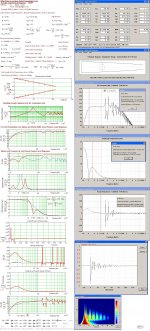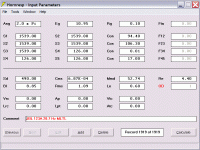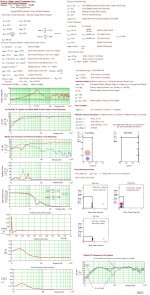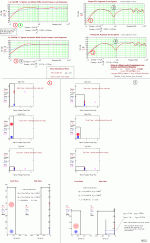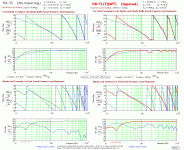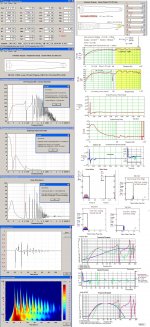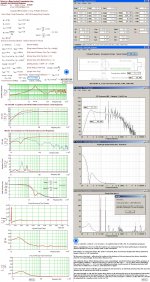Hi,
I'm trying to figure how to make a sub in a TL.
I thought of it because I want to put it in a corner, with a small footprint and as high as it would, up to the roof.
I have the MJK sheets, but never worked with them : wich one could be the good to begin with ?
What type of TL : ML or QW or ??
What SL/S0 ratio ? I was figuring 1/10 ?
The cut will be around 100 Hz.
Thanks for any idea.
I'm trying to figure how to make a sub in a TL.
I thought of it because I want to put it in a corner, with a small footprint and as high as it would, up to the roof.
I have the MJK sheets, but never worked with them : wich one could be the good to begin with ?
What type of TL : ML or QW or ??
What SL/S0 ratio ? I was figuring 1/10 ?
The cut will be around 100 Hz.
Thanks for any idea.
I had asked a simular question few years ago, I remember somebody told me TL enclosure is not very good for making a sub due to the time delay from the open end, it's better to build a horn sub for more spl gain, sealed or passive radiator for faster sound, vented for deeper(I don't agree for the last, but not sure)
All right reserved, I'll keep the final right in explaining what a I said
All right reserved, I'll keep the final right in explaining what a I said
I had asked a simular question few years ago, I remember somebody told me TL enclosure is not very good for making a sub due to the time delay from the open end, it's better to build a horn sub for more spl gain, sealed or passive radiator for faster sound, vented for deeper(I don't agree for the last, but not sure)
All right reserved, I'll keep the final right in explaining what a I said
Who told you that crap?
Horns and TL are both efficient designs.
http://www.t-linespeakers.org/
Last edited:
I forgot who told me this man, coz it happened few years ago.
... but where to begin ?...For QWTL, I use the alignement tables..I want to use a JBL 123A...
Hi, Begin here...
b
Attachments
Interesting, to my way of thinking a MLTL is better overall regardless of its Qts when a T/S alignment specs a short vent length to keep vent mach low enough, so what am I missing?
GM
Hi GM, You are generally right but the OP wants a slim tall ML-TL corner placed, i.e. not folded. I will post my conclusions later....
http://www.diyaudio.com/forums/full-range/192263-sp200x-mltl.html..
b
Hi bjorno, thanks for all !!
I will go deeper in your pict, but first, the last sentence :
"Fs/Qes = 48 suit a closed box (TL not ML-TL)"
Could you precise the braket part : why TL not ML-TL ?
Hi, Sorry for I'm very late again.
Note. I'm only referring to your requirements found in your post#1.
A slim low footprint ML-TL has a very different FR compared to a folded TL (slim), both derived from driver suitability in a flat FR 4:th order slope BR box.
A folded ML-TL has a good FR but would not comply with small footprint if corner placed = ruled out.
The first posted picture here below is a simulation of a folded ML-TL,the next is a comparison with a straight ML-TL with a folded and the last one is a comparison only valid in far-field(not indoors) where anyone can examine the difference of a ML-TL and a TL(TQWT) when made as equal as possible, not by the taper or lengths but everything else.
I would anytime choose the TL(TQWT) for your application (sub with FR below ~100Hz).
b
Attachments
Last edited:
bjorno,
thanks for this amazing answer !
I will need time to dig in !
More to dig into: Adding a T-TQWT to the collection.
b
Attachments
bjorno,
I've made some progress : I've DL Hornresp !
and begun to use it.
So :
1 thanks for paralleling (?) the HR and the MJK responses, it's very useful.
2 what does T-TQWT stands for ?
3 Why the straight MLTL does not have the same response as the folded one ?
Is it because of the longer port, the fold, the fact that the driver is close to the ground , or ?
4 I certainly will have other questions...

I've made some progress : I've DL Hornresp !
and begun to use it.
So :
1 thanks for paralleling (?) the HR and the MJK responses, it's very useful.
2 what does T-TQWT stands for ?
3 Why the straight MLTL does not have the same response as the folded one ?
Is it because of the longer port, the fold, the fact that the driver is close to the ground , or ?
4 I certainly will have other questions...
bjorno,
I've made some progress : I've DL Hornresp !
and begun to use it.
So :
1 thanks for paralleling (?) the HR and the MJK responses, it's very useful.
2 what does T-TQWT stands for ?
3 Why the straight MLTL does not have the same response as the folded one ?
Is it because of the longer port, the fold, the fact that the driver is close to the ground , or ?
4 I certainly will have other questions...

T-TQWT is a short-form for Tapped-Tapered_Quarter-Wave-Tube.
In reality when the room boundary's mirrors the driver and port in the walls,at the floor and in the ceiling: The summation of all 'sources' amplitudes(phases) are all dependent of the listening distance.
When the C-C distance between the driver and port correspond to a half-wave distance for a certain frequency a cancellation dip will occur.
A ~quarter-wave distance to any boundary will too introduce cancellation attenuation, minimum for a folded ML-TL when the driver and port are physically close at a very short distance from the corner junction.
See the submitted picture for more..
b
Attachments
- Status
- This old topic is closed. If you want to reopen this topic, contact a moderator using the "Report Post" button.
- Home
- Loudspeakers
- Subwoofers
- Sub in TL
